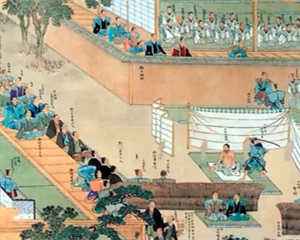He then gave the official the chance of a nobleman's death by committing seppuku.
然后浪人给了Kira切腹自杀的机会。
According to some versions, ōishi even produced the same wakizashi that his master used, but this may be one of Mitford's added elements for dramatic effect.
有的版本的故事说ōishi甚至打造了一把和他的主人一样的长刀,但这可能是Mitford为了达到戏剧效果而添加的元素之一。
Either way, Kira had no interest in any kind of death so he kept begging for mercy.
不管怎样,Kira对任何形式的死亡都不感兴趣,所以他一直在乞求怜悯。
Unsurprisingly, given all they went through, this had no effect on the ronin.
不出所料,浪人考虑到自己所经历的一切,并不为所动。
Eventually tiring of the old man's pleas, ōishi forced him on his knees and cut off his head.
最后ōishi终于厌倦了Kira的恳求,强迫他跪下来,砍下了他的头。
The ronin collected Kira's head in a bucket and prepared to leave, but made sure to put out all of the lights so as not to start a fire that might damage the neighbors' houses.
浪人把Kira的头装进桶里准备离开,同时还确保把所有的灯都灭了以免引起火灾,烧坏邻居的房子。
The Final Road With their mission accomplished, the 47 ronin embarked on a new journey to Sengaku-ji in Takanawa where their master's grave was located with the intent of presenting Kira's head as an offering and fulfillment of their duty before turning themselves in.
任务完成后,47名浪人开始了前往Takanawa的Sengaku-ji的新旅程,他们的主人就葬在那里,他们打算把Kira的头作为祭品供奉给主人,并在自首前完成自己的使命。
They had to hurry.
他们时间紧迫。
Word of their deed had spread quickly throughout the town and, when it reached Lord Uyesugi Sama, he would have surely sent his men to cut them down.
他们的行动很快传遍了整个城镇,一旦消息传到Uyesugi Sama大人那里,他肯定会派人将浪人击杀。
But they soon discovered that, apart from him, everyone else was very impressed with their actions.
但他们很快发现,除了Uyesugi Sama,所有人都对他们的行为大加赞赏。
It was, after all, what was expected of a true samurai.
毕竟,这就是一个真正的武士该有的样子。
Word even reached a chief daimyo named Matsudaira Aki, a former superior of the Asano clan, who was greatly pleased with the ronin and sent his own guards to ensure their protection on the road to Takanawa.
这个消息甚至传到了浅野家族的前任长官Matsudaira Aki那里,他对这些浪人们非常满意,并派了自己的卫兵在去往高川的路上保护他们。
When the men reached the palace of the Prince of Sendai, he, too, was satisfied with their actions, and invited them to eat, drink and rest, before continuing on their journey.
当浪人们到达Prince of Sendai的宫殿时,Matsudaira Aki也对他们的行为非常满意,包了他们的衣食住行,然后浪人继续他们的旅程。
And so the 47 ronin reached their destination safely, performed the offering and said prayers at their master's tomb.
后来,47名浪人安全到达了目的地,在他们主人的墓前献上了祭品并进行了祈祷。
Except that the 47 were actually 46.
除此之外,47浪人其实是46人。
One of the ronin named Terasaka Kichiemon had been absent from the procession to the temple, although what exactly had happened to him remains somewhat of a mystery.
浪人之一Terasaka Kichiemon并没有出现在前往Sengaku-ji寺庙的队伍当中,至于他发生了什么至今仍是一个谜。
He didn't die in the fight.
他并没有死在战斗中。

He also didn't commit seppuku alongside the rest of the ronin as he lived to the ripe old age of 83.
也没有和其他浪人一起切腹自杀,因为他活到了83岁高龄。
Mitford makes no mention of him in his version of the events, although subsequent stories suggest that Terasaka, because he was the lowest in rank, was dispatched as a messenger to travel to the Ako domain and tell Asano's family of what had happened.
在Mitford的描述中并没有提到这个人,不过后来的故事表明,因为Terasaka能力较低,他被派往了赤穗,告诉浅野的家人所发生的事情。
However, some historical documents indicate that the ronin may have simply fled before the attack and abandoned the raid altogether, which is why he wasn't sentenced to death like all the others.
然而,一些历史文献表明,浪人Terasaka在袭击前就逃跑了,完全放弃了袭击,这就是为什么他没有像其他浪人一样被判处死刑。
This goes against the triumphant, heroic tale of the 47 ronin, though, and because there is nothing conclusive to support it, this part of the story usually gets "forgotten" in retellings.
不过,因为这件事与47浪人胜利的英雄故事背道而驰,而且没有确凿的证据,所以故事的这一部分通常在复述中被“遗忘”。
As far as the other 46 ronin were concerned, what they expected to happen, happened.
对于其他46个浪人来说,他们所期望的发生了。
They were arrested and sentenced to death.
他们被逮捕并判处了死刑。
However, because many saw their actions as righteous and justified, they were not executed as criminals, but were allowed to commit seppuku.
然而,因为很多人认为他们的行为是正义的,他们没有被当作罪犯处死,而是被允许切腹自杀。
Afterwards, they were all buried at Sengaku-ji next to their lord. The 47th ronin joined them upon his death.
后来,他们都被葬在Sengaku-ji,葬在他们的主人旁边,再往后第47个浪人死后也被葬在了那里。
Their graves had become a popular place of pilgrimage and one of the many people who came to pay their respects was the same Satsuma man who once kicked and spat on ōishi in the street when he thought the ronin had become a drunkard unworthy of the name "samurai."
他们的坟墓已经成为了一个很受欢迎的朝拜之地,在那些前来祭拜他们的人当中,有一个曾经在大街上对ōishi拳打脚踢、吐唾沫的萨摩人,因为当时他认为这个浪人已经变成了一个不配称为“武士”的酒鬼。
He apologized for his insult and offered atonement by taking out a dagger and stabbing himself in the stomach, dying in front of ōishi's grave.
他为自己的侮辱道歉,并拿出匕首刺向自己的腹部,在ōishi的坟墓前死去。
This wasn't a unique case.
他并不是特例。
Mitford also mentions a samurai who, almost 170 years later, committed seppuku before the grave of ōishi Chikara because he was refused entry into a clan.
Mitford还提到,大约170年后,还有一名武士在ōishi Chikara的坟墓前切腹自杀,因为他被拒绝进入一个氏族。
In modern times, there is a festival at Sengaku Temple every December 14.
现在,Sengaku寺在每年的12月14日都会举行庆典。
Not as many cases of seppuku nowadays, but people still turn up to help commemorate the tale of the 47 ronin.
现在切腹自杀的例子已经不多了,但人们还是会来纪念47浪人的故事。











